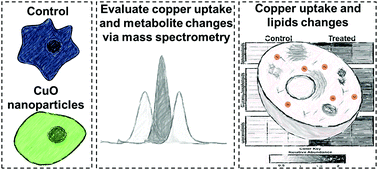当前位置:
X-MOL 学术
›
Mol. Omics
›
论文详情
Our official English website, www.x-mol.net, welcomes your
feedback! (Note: you will need to create a separate account there.)
Lipidomics reveals insights on the biological effects of copper oxide nanoparticles in a human colon carcinoma cell line
Molecular Omics ( IF 3.0 ) Pub Date : 2018-12-05 , DOI: 10.1039/c8mo00162f N G Chavez Soria 1 , D S Aga , G E Atilla-Gokcumen
Molecular Omics ( IF 3.0 ) Pub Date : 2018-12-05 , DOI: 10.1039/c8mo00162f N G Chavez Soria 1 , D S Aga , G E Atilla-Gokcumen
Affiliation

|
Engineered nanomaterials have unique properties compared to their bulk counterparts. Copper oxide nanoparticles (CuO NPs) are one example of nanomaterials used in a wide range of consumer products due to their conductivity and biocidal properties. While CuO NPs can induce toxicity in various organisms, their interactions with different organisms and how they affect cellular homeostasis is yet to be fully understood. In this work, the toxicity of CuO NPs was evaluated in different human cell lines (colorectal carcinoma, cervical cancer, embryonic kidney, and lung fibroblast), showing a dose-dependent toxicity. An untargeted lipidomics approach using liquid chromatography-quadrupole time of flight mass spectrometry was employed in a human colon carcinoma cell line to investigate the impact of CuO NP exposure at the cellular level. A 24 h CuO NP exposure at 2.5 and 5 μg mL−1 resulted in upregulation of different metabolites: triacylglycerols, phosphatidylcholines, and ceramides accumulated. The most profound increase in a dose-dependent manner was observed in ceramides, specifically in C18:0, C18:1, and C22:0 species, with up to ∼10 fold accumulations. Further experiments suggested that activation of autophagy and oxidative stress could be responsible for the toxicity observed in these cell lines. Increases in the level of glutathione oxide (∼7 fold) also supported the activation of oxidative stress upon CuO NP treatment. Based on the changes in different metabolites induced by CuO NP exposure and previous studies from our laboratory, we propose that autophagy and oxidative stress could play a role in CuO NP-induced toxicity.
中文翻译:

脂质组学揭示了对人类结肠癌细胞系中氧化铜纳米粒子生物学效应的见解
与大量同类产品相比,工程纳米材料具有独特的性能。氧化铜纳米颗粒(CuO NPs)由于其导电性和杀菌特性,是广泛用于消费类产品的纳米材料的一个例子。尽管CuO NPs可以在多种生物中诱导毒性,但它们与不同生物的相互作用以及它们如何影响细胞体内平衡尚待充分了解。在这项工作中,对CuO NPs在不同的人类细胞系(结直肠癌,宫颈癌,胚胎肾和肺成纤维细胞)中的毒性进行了评估,显示出剂量依赖性毒性。在人类结肠癌细胞系中使用了液相色谱-四极杆飞行时间质谱法的非靶向脂质组学方法来研究CuO NP暴露在细胞水平上的影响。-1导致不同代谢物的上调:积累的三酰基甘油,磷脂酰胆碱和神经酰胺。在神经酰胺中,特别是在C18:0,C18:1和C22:0物种中,观察到剂量依赖性最显着的增加,累积多达约10倍。进一步的实验表明,自噬和氧化应激的激活可能是这些细胞系中观察到的毒性的原因。谷胱甘肽氧化物水平的增加(约7倍)也支持了CuO NP处理后氧化应激的激活。基于CuO NP暴露诱导的不同代谢产物的变化以及我们实验室的先前研究,我们认为自噬和氧化应激可能在CuO NP诱导的毒性中起作用。
更新日期:2019-02-13
中文翻译:

脂质组学揭示了对人类结肠癌细胞系中氧化铜纳米粒子生物学效应的见解
与大量同类产品相比,工程纳米材料具有独特的性能。氧化铜纳米颗粒(CuO NPs)由于其导电性和杀菌特性,是广泛用于消费类产品的纳米材料的一个例子。尽管CuO NPs可以在多种生物中诱导毒性,但它们与不同生物的相互作用以及它们如何影响细胞体内平衡尚待充分了解。在这项工作中,对CuO NPs在不同的人类细胞系(结直肠癌,宫颈癌,胚胎肾和肺成纤维细胞)中的毒性进行了评估,显示出剂量依赖性毒性。在人类结肠癌细胞系中使用了液相色谱-四极杆飞行时间质谱法的非靶向脂质组学方法来研究CuO NP暴露在细胞水平上的影响。-1导致不同代谢物的上调:积累的三酰基甘油,磷脂酰胆碱和神经酰胺。在神经酰胺中,特别是在C18:0,C18:1和C22:0物种中,观察到剂量依赖性最显着的增加,累积多达约10倍。进一步的实验表明,自噬和氧化应激的激活可能是这些细胞系中观察到的毒性的原因。谷胱甘肽氧化物水平的增加(约7倍)也支持了CuO NP处理后氧化应激的激活。基于CuO NP暴露诱导的不同代谢产物的变化以及我们实验室的先前研究,我们认为自噬和氧化应激可能在CuO NP诱导的毒性中起作用。











































 京公网安备 11010802027423号
京公网安备 11010802027423号